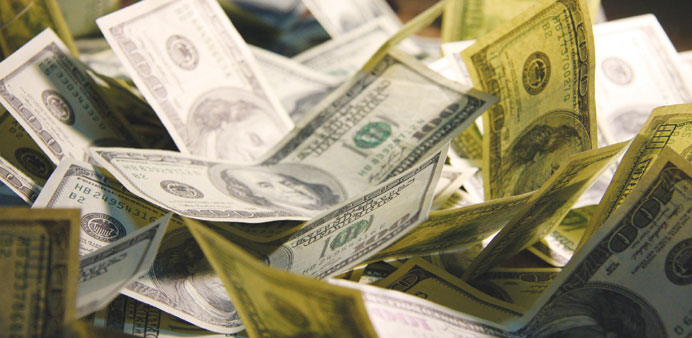Bloomberg
London
The dollar retreated following its longest weekly rally of 2015 as the selloff in stocks and commodities fuelled concern global growth will sag as the US considers raising interest rates.
The slump in raw materials and global equities, with China’s benchmark index plunging the most in eight years, weighed on the dollar. The US currency weakened against 13 of its 16 major peers. The Federal Reserve meets this week to consider when to tighten monetary policy for the first time since 2006. The euro reached its highest in two weeks against the dollar, after the easing of tensions over Greece helped a measure of German business confidence to an unexpected rebound.
“The weakness in commodity prices is prompting some market participants to doubt whether the Fed will begin to raise rates in September,” said Lee Hardman, a currency strategist at Bank of Tokyo-Mitsubishi UFJ in London. “This obviously takes some of the shine off the dollar in the very near term.”
The Bloomberg Dollar Spot Index, which tracks the currency against 10 major peers, declined 0.4% to 1,204.57 yesterday in New York, after rising to 1,212.78 on Friday, the highest since March 19. The gauge has gained for the past five weeks, the longest stretch this year.
The dollar weakened 0.8% versus the euro to $1.1073. It had earlier reached $1.1113 per euro, its weakest since July 13. The US currency fell 0.5% to 123.22 yen.
Dollar bulls have been in the ascendancy since the middle of June as Greece inched toward a bailout deal, allowing traders to focus on Fed policy. Large speculators boosted wagers for a fifth week that the US currency will rise against its major peers, the longest run this year.
Fed Chair Janet Yellen, who will oversee the two-day Federal Open Market Committee policy meeting starting today, said earlier this month she expected to raise borrowing costs this year, with subsequent increases proceeding gradually.
“At Yellen’s congressional testimony, she did not rule out a September hike,” wrote Adam Cole, London-based head of global foreign-exchange strategy at Royal Bank of Canada, in a note to clients. “Nor did she guide the market towards thinking September was a done deal,”
“We think the upcoming FOMC statement will reflect this non-committal approach,” where “there will be no explicit tweak to the guidance signaling a hike is imminent,” he said, adding that he still expects a September interest-rate rise.
Investors increased bullish dollar bets to 375,137 contracts in the week ended July 21, the most since March 24, based on data from the Commodity Futures Trading Commission in Washington.
Earlier this month Yellen had reiterated that the Fed increasing interest rates will depend on “unfolding data in the months ahead.”
Gross domestic product data for the second quarter releasing Thursday is forecast to show the economy grew by 2.5%, recovering from a contraction of 0.2% in first three months of the year, according to a Bloomberg survey of economists.
While stronger US data supports the case for a rate rise in September the Fed could be cautious and delay policy tightening if commodity prices continue to slide.
“Right now the market is really struggling,” said BTMU’s Hardman. “It is looking for a fresh catalyst for direction and we are not expecting the Fed to provide it this week. The Fed will still deliver a rate hike this year but whether or not they go as soon as September still remains in balance.”
There’s a 40% chance the Fed will increase its benchmark rate by September, according to futures data compiled by Bloomberg.
A week ago the odds were 33%. The central bank has kept its benchmark in a range between zero and 0.25% since December 2008 to spur growth.

